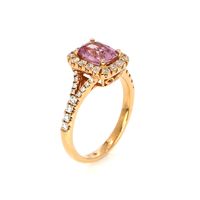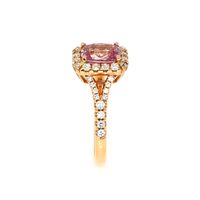Metal Terminology
J5422| play | right| “4.35 Ct. Mozambique No Enhancement Sapphire Ring”Navigating the world of gemstone jewelry requires a solid grasp of metal terminology, as the choice of metal not only influences the appearance and durability of a piece but also its suitability for different skin types and aesthetic preferences. Metal terminology encompasses a wide range of terms, from the types of metals used, such as gold, silver, platinum, and palladium, to their properties, such as hardness, color, and tarnish resistance. Understanding this metal terminology is essential for anyone looking to make informed decisions when selecting jewelry, whether for personal use or as a gift.
For instance, knowing the differences between 14k and 18k gold, or the hypoallergenic properties of platinum, can significantly impact the longevity and enjoyment of a piece.
Karat vs. Carat
- Karat (K) – Gold’s Purity Indicator: The term ‘karat’ is pivotal in the precious metals arena, signifying the purity of gold. Pure gold, known for its softness, is typically alloyed for added strength. The karat value, such as 18K, tells you the actual gold content – 18 parts gold and 6 parts other metals, offering a balance of preciousness and practicality.
- Carat (ct) – The Standard for Gemstone Weight: Moving from metals to gemstones, ‘carat’ steps in as a unit of weight. Each carat is equivalent to 200 milligrams. The carat weight is integral in assessing a gemstone’s value and size, serving as a universal scale for comparing different stones.
Plating and Vermeil
- Plating – Metal Enhancement Technique: Plating transforms a basic metal by covering it with a layer of precious metal, such as gold or silver. This method allows for the luxurious appearance of precious metals at a more accessible price point. Remember, though, that over time and with wear, the plating may gradually wear away, revealing the base metal beneath.
- Vermeil – Premium Gold Plating Over Silver: Vermeil, a distinguished form of gold plating, involves a thick layer of gold over a sterling silver base. Recognized for its quality, vermeil must use at least 10-karat gold, offering a more durable and high-end finish compared to standard gold plating.
Common Metal Alloys
- Sterling Silver – A Shining Composite: Sterling silver is an admired alloy, comprising 92.5% silver and a 7.5% mix of other metals, typically copper. This composition strikes an optimal balance, providing both the desired luster and increased durability, making it a favorite in jewelry design.

- Rose Gold – Elegance Tinted with Warmth: A delightful variation of traditional gold, rose gold is an alloy that combines gold with copper, giving it a captivating pinkish hue. The copper proportion varies, allowing for a range of shades from soft pink to deeper rose tones.




- White Gold – The Modern Twist on Gold: White gold is a contemporary alternative to classic yellow gold, blending gold with white metals like nickel or palladium, and often coated with rhodium for extra durability and a bright finish. It’s sought after for its sophisticated, silvery appearance and the prestige of gold.
-cushion-blue-sapphire-engagement-ring-8.3800-cts-j10190-1.jpg?d=200x200&v=20240520143654)
-cushion-blue-sapphire-engagement-ring-8.3800-cts-j10190-2.jpg?d=200x200&v=20240520143654)
-cushion-blue-sapphire-engagement-ring-8.3800-cts-j10190-3.jpg?d=200x200&v=20240520143654)
-cushion-blue-sapphire-engagement-ring-8.3800-cts-j10190-4.jpg?d=200x200&v=20240520143654)
- Stainless Steel – The Robust Choice: In the realm of jewelry, stainless steel is prized for its formidable composition, typically an alloy of iron, chromium, and carbon. Known for its resistance to corrosion and tarnishing, stainless steel brings a modern edge to jewelry, suitable for various styles.

Key Highlights:
- Karat (K): This signifies the proportion of gold in an alloy.
- Carat (ct): Measures the weight of gemstones.
- Plating: Offers an affordable way to achieve a gold or silver finish.
- Vermeil: Represents a higher-quality gold plating on sterling silver.
- Sterling Silver: Renowned for its luster and versatility in jewelry.
- Rose Gold: Known for its characteristic pink color due to copper.
- White Gold: A chic alternative to yellow gold, often rhodium-plated.
- Stainless Steel: Distinguished by its durability and modern appeal.

This exploration into metal terminology within the context of gemstones and jewelry uncovers the subtleties of karat vs. carat, the nuances of plating and vermeil, and the intricate makeup of common metal alloys. Such knowledge is crucial for jewelry enthusiasts and practitioners, shedding light on the materials that forge the essence of jewelry. From the rich purity of gold in various karats to the importance of carats in evaluating gemstones, from the transformative allure of plating to the refined elegance of vermeil, and from the timeless charm of sterling silver to the avant-garde robustness of stainless steel, every element plays a vital role in the narrative of jewelry creation. This understanding not only deepens appreciation but also guides discerning choices, ensuring that each piece of jewelry is not just an accessory but a testament to informed craftsmanship and enduring elegance.
